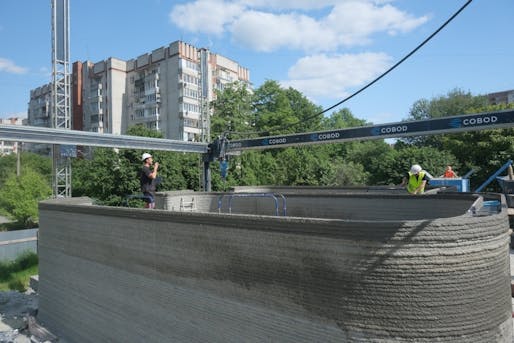The enormous effort of rebuilding civilian infrastructure in war-torn Ukraine has spurred a landmark example of the design and delivery of 3D printed architecture with the completion of Danish 3DCP Group‘s new Lviv School No. 23 project in the country’s internally-deluged western stronghold.
Their humanitarian design for clients Team4UA foundation was completed earlier this spring using a COBOD BOD2 printer and is now the title holder for the world’s largest 3D printed educational structure, simultaneously helping to bolster a key area of need in a community beleaguered by over 16 months of conflict and displacement.
Ukraine as a whole has lost some 277 schools since the latest phase of the Russian military invasion began last February, according to its Ministry of Education and Science. Jean-Christophe Bonis, a French-born entrepreneur who has resided in the country since 2019, took it as his charge to redirect his business activities towards the war effort, leading to the creation of Team4UA and the construction of the new school project, which is also the first of its kind anywhere on the continent.
His collaborator, Henrich Lund-Nielsen (founder of COBOD International), told the BBC recently: “We felt that we had to do something to honor the fighting will that Ukraine has shown. […] There’s a lot of positive vibes now, and obviously we hope that this will be a beacon also and to instill in the Ukrainian people that there is a future and we can rebuild the country.”
The total 3,982-square-foot construction was completed over a period of months by joining two concrete segments and a third separate wooden component with the deliberate exclusion of COBOD’s proprietary flap exterior coverings to showcase the design potential of 3D printing technology, which the foundation plans to use in later projects throughout Ukraine and Turkey. (Nielsen mentioned the technology had previously been employed in 25 different countries across the world.)
The printing equipment can be enacted quickly thanks to its modular nature, offering builders what Nielsen called a “factory on wheels.” A two-week training session is all that’s required, and costs are cut down dramatically versus traditional construction methods, which offer added value considering the strain on labor demanded by other critical infrastructure projects and still-mandatory military conscription.
A total of 90% of the materials used in construction were derived from local sources, with nearly all (99%) of the concrete also being sourced from the local economy. A video documentation of the 3D printed construction can also be viewed below.
[embedded content]
Video courtesy of COBOD, via YouTube.
This post was originally published on this site be sure to check out more of their content.













